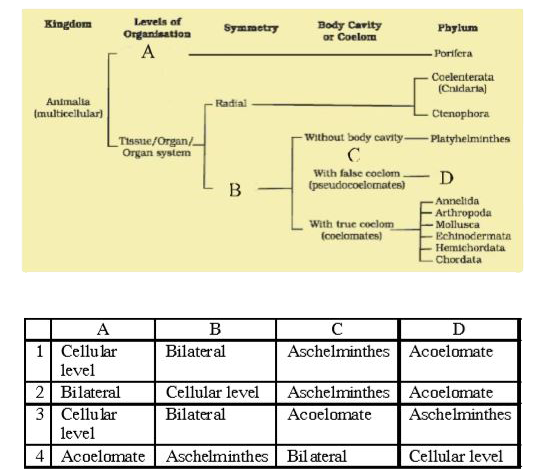(A) inspiratory capacity
(B) expiratory capacity
(C) functional residual capacity
Choose the correct option for A , B and C
(1) A-TV+ERV,B-TV+IRV,C-EVR+RV
(2) A-TV+ERV,B-TV+ERV,C- TV+IRV
.(3) A-TV+IRV,B-TV+ERV,C-EVR+RV
(4) A-TV+ERV,B-TV+IRV,C-EVR+RV
The correct Answer is:C
To answer the question regarding the definitions of inspiratory capacity, expiratory capacity, and functional residual capacity, we will break down each term step by step.
1. Inspiratory Capacity (A):
- Definition: Inspiratory capacity is the total volume of air that a person can inhale after a normal expiration.
- Components: It is calculated by adding the tidal volume (TV) and the inspiratory reserve volume (IRV).
- Formula:
Inspiratory Capacity (IC)=Tidal Volume (TV)+Inspiratory Reserve Volume (IRV)
2. Expiratory Capacity (B):
- Definition: Expiratory capacity is the total volume of air that a person can exhale after a normal inspiration.
- Components: It is calculated by adding the tidal volume (TV) and the expiratory reserve volume (ERV).
- Formula:
Expiratory Capacity (EC)=Tidal Volume (TV)+Expiratory Reserve Volume (ERV)
3. Functional Residual Capacity (C):
- Definition: Functional residual capacity is the volume of air that remains in the lungs after a normal expiration.
- Components: It is calculated by adding the expiratory reserve volume (ERV) and the residual volume (RV).
- Formula:
Functional Residual Capacity (FRC)=Expiratory Reserve Volume (ERV)+Residual Volume (RV)
Final Answers:
- (A) Inspiratory Capacity = Tidal Volume + Inspiratory Reserve Volume
- (B) Expiratory Capacity = Tidal Volume + Expiratory Reserve Volume
- (C) Functional Residual Capacity = Expiratory Reserve Volume + Residual Volume
- Definition: Inspiratory capacity is the total volume of air that a person can inhale after a normal expiration.
- Components: It is calculated by adding the tidal volume (TV) and the inspiratory reserve volume (IRV).
- Formula:
Inspiratory Capacity (IC)=Tidal Volume (TV)+Inspiratory Reserve Volume (IRV)
- Definition: Expiratory capacity is the total volume of air that a person can exhale after a normal inspiration.
- Components: It is calculated by adding the tidal volume (TV) and the expiratory reserve volume (ERV).
- Formula:
Expiratory Capacity (EC)=Tidal Volume (TV)+Expiratory Reserve Volume (ERV)
- Definition: Functional residual capacity is the volume of air that remains in the lungs after a normal expiration.
- Components: It is calculated by adding the expiratory reserve volume (ERV) and the residual volume (RV).
- Formula:
Functional Residual Capacity (FRC)=Expiratory Reserve Volume (ERV)+Residual Volume (RV)
- (A) Inspiratory Capacity = Tidal Volume + Inspiratory Reserve Volume
- (B) Expiratory Capacity = Tidal Volume + Expiratory Reserve Volume
- (C) Functional Residual Capacity = Expiratory Reserve Volume + Residual Volume
Topper's Solved these Questions
Similar Questions
Functional residual capacity is -
View SolutionExpiratory capacity is
View SolutionExpiratory capacity is
View SolutionWhat is functional residual capacity?
View SolutionInspiratory capacity and Expiratory capacity
View SolutionExpiratory capacity - Inspiratory capacity + X = Functional residual capacity . X in this equation is
View SolutionMark the option that defines functional residual capacity
View SolutionDifferentiate between Inspiratory capacity and expiratory capacity
View SolutionComplete the following chart by choosing correct option for A , B ,C and D

View SolutionDistinguish between :
Inspiratory capacity and Expiratory capacity
View Solution
